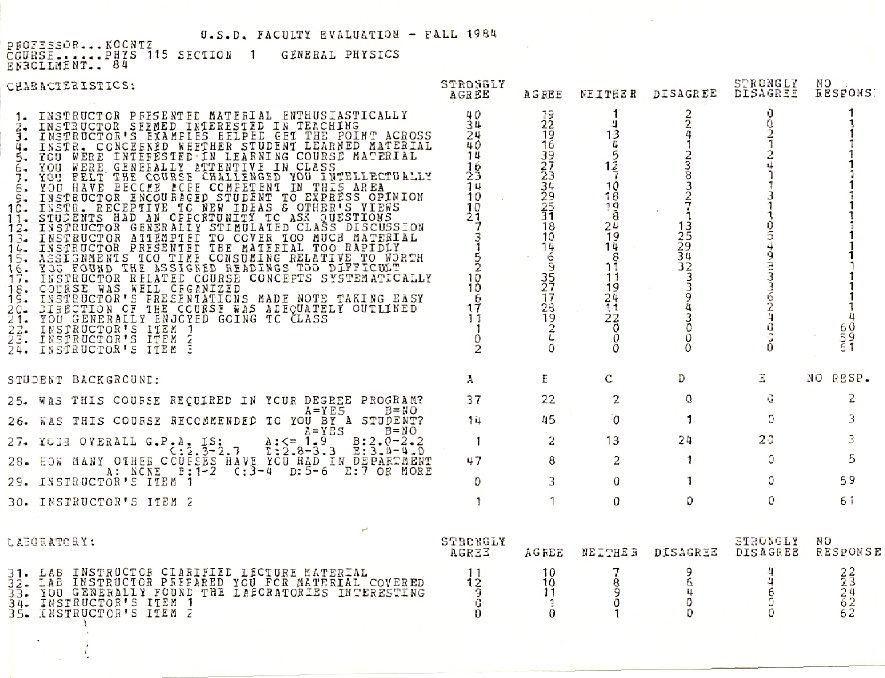|
Additional Background Material I have included below a news article about me when I became employed as a Staff Scientist (II) at the Lawrence Berkeley Laboratory. I have also included a news article about my involvement in an important high energy physics experiment done in the 1975-1978 time frame -- using the electron-positron intersecting storage ring at the Stanford Linear Accelerator Center. That experiment in fact led to discovery of a particle known as the tau lepton. -- for which a Nobel prize was won by Perl in 1995. With respect to documenting my background, there are also copies of my Ph.D., Master's and Bachelor's degrees shown below, and I have also added a copy of my Honorable Discharge from the US Navy. In addition, there are copies of my last Navy evaluation report from when I worked at the National Security Agency, and there are also evaluation reports from when I worked as an Assistant Professor of Physics at the University of South Dakota . Other forms of documentation have also been included, such as letters of recommendation from other physicists and a letter of recommendation from Sam Hayes, a friend of the family and then a Pennsylvania State Representative. I believe that this documentation should prove sufficient to establish my credentials as a physicist beyond a reasonable doubt. That is what I am hoping to do -- as otherwise some of what I have to say concerning such things as antigravity and free energy might be hard for some to believe. Please scroll down. -- Bob Koontz |
ince I am beginning to address what I believe will be a very controversial s
ubject, I am placing this information here to ensure there is no doubt t.
| The article below describes my research at the Lawrence Berkeley Laboratory and mentions my Navy background |
| Below is an article which describes some of the particle physics work I did at the Stanford Linear Accelerator Center (SLAC). The experiment in which I was involved helped lead to the discovery of a new particle called the tau lepton -- for which a Nobel prize was won by Perl. My role in the experiment described below involved creation of certain kinds of particle detectors for charged and uncharged particles. The uncharged particle detector was a large lead-glass system of gamma ray detectors., The charged particle detector was a more conventional ionization system where many gold-plated tungsten wires are stretched across a frame and then placed at high voltage. The system is filled with a gas known as "magic gas" that ionizes when charged particles pass near any one of the wires. |
| The
four pictures below relate to sensitive work I did from 1985 until
2002. The mathematics shown involves numerical multi-dimensional
integration. That was an extension of work I did at the University
of Maryland, the Lawrence Berkeley Laboratory and then the University
of South Dakota where a student and I did numerical integrations
in 20 dimensions. In that time period, from 1978 until about
1985, very few people were doing this kind of mathematics -- which
was, and is, very useful in computer modeling of complex
systems. Most of the other subjects listed below I am not
free to say much about. During this time, I was head of my
own consulting company. I quit this line of work in 2002 when I decided
to pursue research relating to antigravity and free energy. |
|
Below is a copy of my Ph.D. degree. As can be seen, the degree was awarded in 1980 from the University of Maryland. All of my college degrees were awarded at the University of Maryland -- with transfer credits from the Johns Hopkins University. |
|
Master's degree was awarded in 1978 |
|
Bachelor's of Science degree was awarded in 1975 -- with honors in physics. |
| This is an award
I received while working at the National Security Agency I have redacted the name of the course. |
|
July 1971 Honorable Discharge from the U.S. Navy |
| Just a little award for helping out in the National Science Olympiad |
| Letter of
recommendation from a state representative who is also a friend of the family. |
The
picture below was taken just after I earned my Ph.D.
at the University of Maryland in 1980
The
membership cards shown below correspond to some of the organizations
I belong to or have previously belonged to during my professional
career.
|
The letter shown below is a copy of a letter of recommendation that my supervisor at the Lawrence Berkeley Laboratory sent to the chairman of the physics department at the University of South Dakota. |
|
The document shown below is a copy of an open letter of recommendation that was written at my request by the Chairman of the Physics Department at the University of South Dakota. |
|
|
The document shown below is a copy of a letter of recommendation sent by my thesis advisor to Lee Schroeder at the Lawrence Berkeley Laboratory. |
| Open letter of recommendation from Don Abraham |
| Letter of recommendation from Professor Harry Holmgren |
|
Letter informing me that I received honorable mention relative to Outstanding Teaching Assistant Award. There were at that time hundreds of teaching assistants at the university, So honorable mention did mean at least a little something. |
| The letter below relates to a student who I looked after when I got the impression that he might be thinking about suicide. |
| Student evaluation reports |

| Performance report |
| Sailor of the month award at Fort Meade Naval Security Group Activity. |
| Last Navy performance report while assigned to the NSA as an electronics instructor |
This relates to help I gave to a fellow physicist